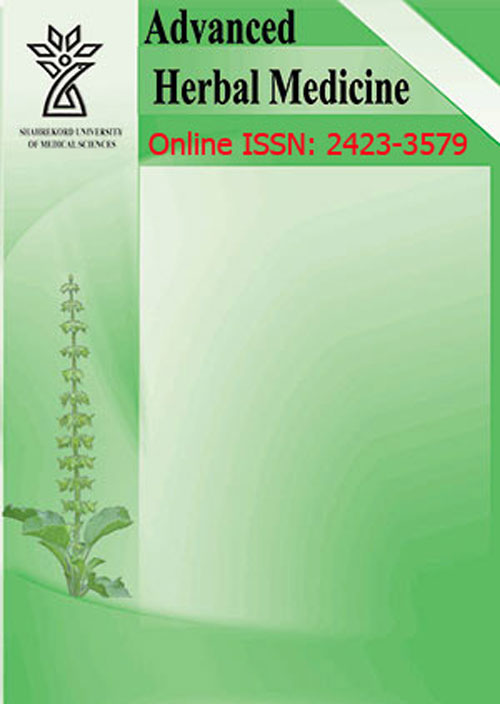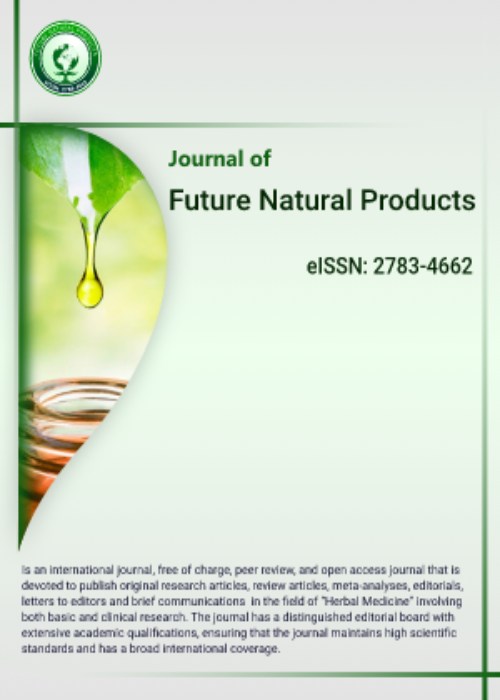فهرست مطالب

Future Natural Products
Volume:6 Issue: 2, Summer-Autumn 2020
- تاریخ انتشار: 1400/07/27
- تعداد عناوین: 5
-
Pages 1-16Background and aimsCurrent therapeutic regimens are not able to solve hormonal imbalance in young multiple sclerosis (MS) women and the clinical benefits of hormone therapy in MS patients remain controversial. This open labeled pilot study was aimed to find the role of Vitex agnus-castus plant supplement daily regimen in serum testosterone level , Expanded Disability Status Scale (EDSS), sexual function and overall quality of life in premenopausal MS patients.MethodsTo achieve these goals, Molecular Docking on Vitex agnus-castus standard fruit extract constitutes performed and 30 eligible patients were selected for the clinical part of this study. Patients received two Vitagnus® film tablets in addition to their drugs for 90 days.ResultsSome plant extract components showed strong affinity to Androgen Receptor Ligand binding domain. Significant reduction in EDSS (1.839 vs.1.643, p=0.003) and significant elevation in serum testosterone levels [388.6(±0.16900) vs. 468. (±0.18144) 2ng/dL (p=0.026)] were also observed at the completion of the intervention. Menstrual irregularities disappeared in all 28 patients who completed this study. MSQL-54 criteria at the completion of study (day 91) showed lower stress levels, improved vitality/emotional health and normalized sexual activities without significant effect on sleep disorders and cognitive functions of patients. Vitex agnus-castus treatment by predictable AR LBD affinity improved the emotional state, sexual life, EDSS score and overall quality of life in premenopausal RRMS patients.ConclusionOur results suggest Vitagnus® film tablet as safe and promising supplement with some benefits in MS women who are suffering from disease induced emotional and sexual impairments.Keywords: multiple sclerosis, Vitex agnus-castus, Quality of Life, Testosterone, Molecular Docking
-
Pages 17-31Background and AimsAnxiety is one of the symptoms of menopause, which is due to stopping of ovarian activity. The aim of this study was to investigate the effect of Foeniculum vulgare L. extract on anxiety-like behaviors in ovariectomized mice.MethodsEighty female mice weighing 25-30 g and aged 6-8 weeks were divided into 10 groups of eight each, controls: the group without ovariectomy given distilled water, positive controls: the ovariectomized group receiving 40 µg/kg of estradiol valerate, the groups without ovariectomy given F. vulgare extract by gavage at 200, 500, and 750 mg/kg, the ovariectomized group given distilled water, the ovariectomized groups given F. vulgare extract at 200, 500, and 750 mg/kg, and the ovariectomized group given diazepam at 1 mg/kg. Elevated plus maze (EPM) and open field were used to investigate anxiety in mice. The level of malondialdehyde (MDA) and total antioxidant capacity (TAC) of the brain and serum were also measured.ResultsIn ovariectomized mice, the number of entries to the closed arms of EPM was significantly increased compared with control group (P<0.05). Treatment of ovariectomized mice with 500 and 750 mg/kg of the extract significantly increased the number of entries to the open arms and significantly decreased the number of entries to the closed arms of EPM (P<0.05). The time spent in the center and the crossing squares in the open field significantly decreased in ovariectomized mice compared with control group and treatment with estradiol significantly increased them (P<0.05). In ovariectomized mice, serum and brain MDA levels significantly increased and their TAC significantly decreased compared with control group. Different doses of extract, estradiol and diazepam significantly reduced MDA levels and increased TAC in both brain and serum (P<0.05).Conclusionvulgare extract may ameliorate the symptoms of anxiety in ovariectomized mice by reducing oxidative stress.Keywords: Foeniculum vulgare L, Anxiety, antioxidant capacity, malondialdehyde
-
Pages 32-48Background and aimsCutaneous leishmaniasis is one of the endemic parasitic diseases in many regions of Iran for which there is currently no complete vaccine and effective drugs without drug resistance to prevent and treat it. Given the need to develop new drugs for the treatment of various diseases with fewer side effects, greater effects with shorter treatment periods, especially in anti-leishmaniasis drug compounds for drug-resistant types of the disease, it is essential to do research on plant compounds containing medicinal compounds to promote the treatment of this infection. The present study was performed to compare the in vitro effects of hydroalcoholic extracts of flower and fruit peel of Punica granatum on Leishmania major promastigotes.MethodsDifferent dilutions of hydroalcoholic extracts of flower and fruit peel of P. granatum were prepared by the maceration method and their in vitro effects on L. major promastigote were investigated using MTT assay. Data were analyzed using SPSS software version 22.ResultsThe results showed that both hydroalcoholic extracts of flower and fruit peel of P. granatum could inhibit the parasite, but the extract fruit peel of P. granatum showed anti-leishmaniasis activity at lower concentrations compared to extract flower of P. granatum.ConclusionThe hydroalcoholic extracts of flower and fruit peel of P. granatum could inhibit the parasite, that probably due to the presence of some compounds such as ellagic acid with antioxidant properties and punicalagin with antimicrobial properties especially in fruit peel extract of P. granatum.Keywords: Punica granatum fruit peel, Punica granatum flower, Leishmania major, antiparasitic activity, in vitro techniques
-
Pages 49-74BackgroundIonotropic glutamate NMDA receptors are multi-subunit proteins with few selective pharmacological ligands and are tentatively implicated in MS and other neurodegenerative disorders. The present study was aimed at evaluating the antioxidant properties of Berberis vulgaris extract-loaded magnetite nanoparticles on the Grin1 gene expression in NMDA receptor in EAE Syrian mice.MethodsEAE mice models were generated through active immunization with MBP and PTx and kept for days 9-14 until EAE signs appeared followed by administration of barberry extract loaded magnetic nanoparticles.ResultsPure BE concentrations did not show recovery signs until days 7-9, but partial recovery in tail movement was seen on days 11 and 14, which was significant as compared to the control group in terms of improvement of the clinical scores. Meanwhile bare nanoparticles had neither disease recovery/progression properties nor EAE mice mortality as compared to controls, but 1 mg BE + Fe3O4 reduced EAE symptom severity and resulted in significant improvement of hind limb sensitivity to toe pinching and improved tail movements. Meanwhile 2 mg Be + Fe3O4 showed much better sensitivity to toe pinching and complete tail recovery. qRT-PCR analysis showed a significant decrease in relative Grin1 expression in female mice after treatment with 0.2 and 1 mg BE. However, a profound decrease in Grin1 expression was seen at 0.2, 1 and 2 mg BE + Fe3O4 treated groups in a dose-dependent manner.ConclusionThe results indicated that Fe3O4+ BE could alleviate the EAE severity and progressionKeywords: NMDA, neuroprotection, Grin1, Syrian mice, Berberis vulgaris
-
Pages 75-79Background and aims
Colchicum autumnale contains an alkaloid called colchicine, which blocks the cell division by inhibiting mitosis. This study investigated a patient who was poisoned with C. autumnale in Iran.
DescriptionThe patient was a 44-year-old man who came to the emergency poisoning ward after a day of hiking and eating soup. He presented with severe nausea and vomiting. The patient was admitted to the ICU two days later with general toxic conditions, complaining of chest pain, nausea, vomiting and shortness of breath. The laboratory tests showed elevated liver enzymes and pancytopenia. He developed respiratory distress and physician had to intubate him. He was treated with antibiotics, GCSF for pancytopenia and antioxidant to protect the liver.
ConclusionThe patient responded to broad spectrum antibiotic, antifungal and GCSF. Paying attention to the patient’s history was the key to appropriate diagnosis
Keywords: toxicology, Poisoning, Colchicinum, Emergency Medicine, Case Report


